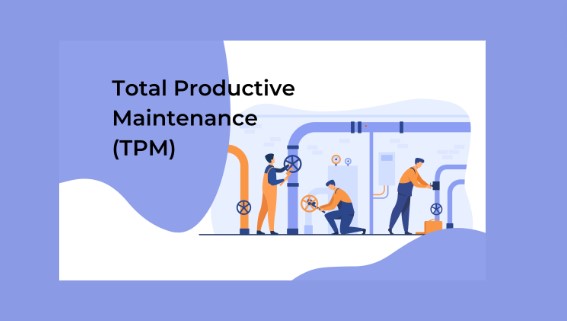
Understanding Total Productive Maintenance
Madhurima Sanyal |
05 Mar 2024 |
15:58 PM
- What Is Total Productive Maintenance?
- Benefits of Total Productive Maintenance
- The Importance of TPM in Manufacturing
- The 8 Pillars of Total Productive Maintenance (TPM)
- Step-by-Step Guide to Implement TPM
- Sustaining TPM Improvements
- Total Productive Maintenance Workflow
- Integration of Core Elements - 8 Pillars
- How to Implement TPM Effectively
- Understanding the 5 Core Elements of TPM
- Best Practices for Implementing TPM in Different Industries
- Calculating TPM
- Methods for Calculating TPM
- Importance of TPM Metrics
- Conclusion
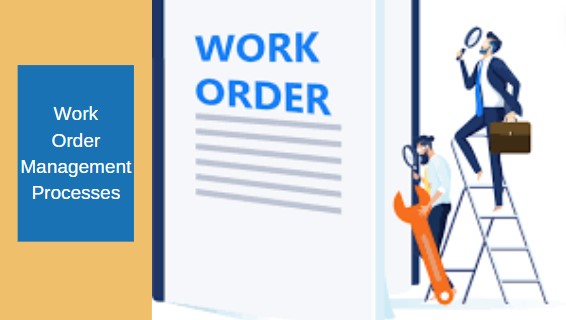
Work Order Management Process: Prioritizing Maintenance Activity
Viki Dongare 18 Feb 2024 | 06:53 AMEnhance operational efficiency and optimize asset performance with effective work order management and maintenance prioritization strategies. Streamline workflows, reduce downtime, and foster a culture of accountability for long-term maintenance succe...
What Is Total Productive Maintenance?
In today's competitive manufacturing landscape, maximizing equipment effectiveness is crucial for staying ahead. TPM plays a pivotal role in achieving this goal by ensuring that equipment operates at peak performance levels consistently. By minimizing unplanned downtime and optimizing maintenance activities, TPM enables manufacturers to meet production targets, maintain product quality, and satisfy customer demand effectively.
Benefits of Total Productive Maintenance
Implementing TPM offers numerous benefits to manufacturing organizations. Firstly, it leads to improved equipment effectiveness, resulting in increased production output and reduced downtime. By addressing maintenance issues proactively, TPM helps prevent costly breakdowns and repairs, thus saving both time and money.
Moreover, TPM fosters a culture of continuous improvement by empowering employees to identify and eliminate inefficiencies in equipment and processes. This not only enhances productivity but also boosts employee morale and engagement.
The Importance of TPM in Manufacturing
In today's competitive manufacturing landscape, maximizing equipment effectiveness is crucial for staying ahead. TPM plays a pivotal role in achieving this goal by ensuring that equipment operates at peak performance levels consistently. By minimizing unplanned downtime and optimizing maintenance activities, TPM enables manufacturers to meet production targets, maintain product quality, and satisfy customer demand effectively.
The 8 Pillars of Total Productive Maintenance (TPM)
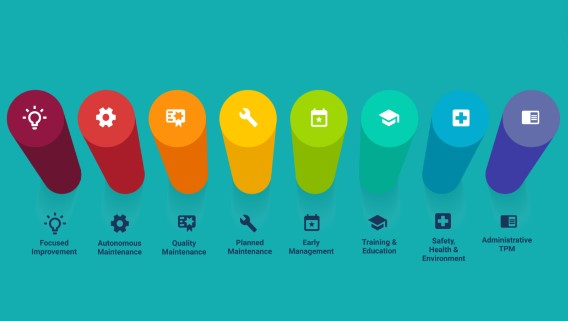
Overview of the Eight Pillars
The Eight Pillars of Total Productive Maintenance (TPM) provide a comprehensive framework for achieving equipment effectiveness and operational excellence. Each pillar, including Autonomous Maintenance, Planned Maintenance, Quality Maintenance, Focused Improvement, Early Equipment Management, Education and Training, Administrative and Office TPM, and Safety, Health, and Environment, plays a crucial role in minimizing downtime, improving product quality, and driving continuous improvement efforts. By implementing these pillars, organizations empower employees, streamline processes, and create a culture of accountability and continuous improvement, ultimately enhancing overall equipment effectiveness and competitiveness in the manufacturing industry.
Importance and Implementation of Each Pillar
Each pillar of TPM plays a vital role in achieving and sustaining equipment effectiveness, minimizing downtime, and driving continuous improvement. Implementation of these pillars requires commitment, collaboration, and a systematic approach to maintenance and operations. By embracing the Eight Pillars of TPM, organizations can unlock their full potential and achieve operational excellence in today's competitive manufacturing landscape.
Each pillar of TPM contributes to achieving and sustaining equipment effectiveness, minimizing downtime, and driving continuous improvement. Implementation of these pillars requires commitment, collaboration, and a systematic approach to maintenance and operations. By embracing the Eight Pillars of TPM, organizations can unlock their full potential and achieve operational excellence in today's competitive manufacturing landscape.
Step-by-Step Guide to Implement TPM
a. Identifying a Pilot Area
Begin by selecting a small area or specific piece of equipment to pilot your TPM implementation. This allows you to focus your efforts and demonstrate the benefits of TPM in a controlled environment.
b. Restoring Equipment to Prime Operating Condition
Conduct a thorough assessment of the selected area's equipment to identify any existing issues or opportunities for improvement. Implement autonomous maintenance practices to address minor issues and restore equipment to optimal performance.
c. Measuring Overall Equipment Effectiveness (OEE)

Utilize OEE metrics to assess the efficiency and effectiveness of the equipment in the pilot area. Measure factors such as availability, performance, and quality to identify areas for improvement and track progress over time.
d. Addressing/Reducing Major Losses
Identify and prioritize the major sources of equipment downtime, inefficiency, and waste within the pilot area. Implement focused improvement initiatives to address root causes and reduce major losses, such as breakdowns, setup times, and defects.
e. Implementing Planned Maintenance
Develop and implement a planned maintenance schedule based on equipment condition and performance data. Schedule routine maintenance tasks, inspections, and repairs to prevent unplanned downtime and ensure equipment reliability and longevity.
Sustaining TPM Improvements
Sustaining the success of Total Productive Maintenance (TPM) requires ongoing commitment and involvement from various stakeholders. By implementing strategies to maintain TPM initiatives, organizations can ensure long-term benefits and continuous improvement in overall equipment effectiveness (OEE) and productivity.
Strategies for Maintaining TPM Success
To sustain TPM improvements, organizations should establish clear goals and metrics to measure progress over time. Regular performance reviews and audits help identify areas for improvement and ensure adherence to TPM principles. Additionally, providing ongoing training and education to employees reinforces the importance of TPM practices and fosters a culture of continuous improvement.
Involvement of Different Stakeholders
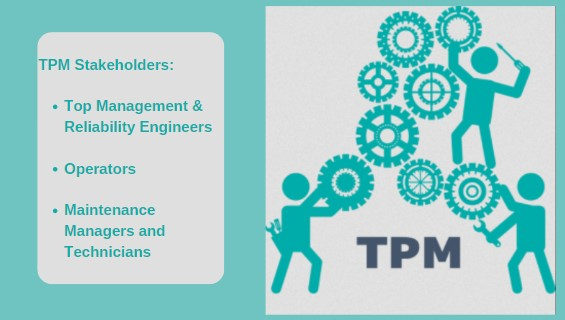
a. Top Management & Reliability Engineers
Top management's role in TPM implementation is pivotal. They provide essential support and allocate necessary resources to ensure the success of TPM initiatives. By demonstrating unwavering commitment to TPM principles and fostering a culture of continuous improvement, top management sets the organizational tone for success. Additionally, reliability engineers play a crucial role by leveraging their expertise in analyzing equipment reliability data. They identify areas for improvement and recommend strategies to enhance equipment performance and reliability.
b. Operators
Operators are the frontline workforce responsible for executing TPM practices on a daily basis. Their involvement is indispensable for the successful implementation of TPM. Operators are often the first to detect equipment issues and abnormalities during operations. By empowering operators to perform autonomous maintenance tasks and actively participate in problem-solving activities, organizations can tap into their firsthand knowledge and experience. This engagement not only enhances equipment reliability but also fosters a sense of ownership and accountability among operators, driving TPM success.
c. Maintenance Managers and Technicians
Maintenance managers and technicians play a pivotal role in TPM implementation by overseeing maintenance activities and ensuring the effective execution of TPM practices. They are responsible for implementing planned maintenance schedules, conducting routine equipment inspections, and performing necessary repairs. Their expertise ensures that equipment remains in prime operating condition and that proactive maintenance techniques are successfully implemented. By providing ongoing training and support to maintenance personnel, organizations can enhance their skills and proficiency in TPM methodologies. This, in turn, maximizes the effectiveness of TPM initiatives and minimizes unplanned downtime, ultimately contributing to improved equipment reliability and operational efficiency.
Involving all stakeholders in the TPM process fosters a sense of ownership and accountability, leading to sustained improvements in equipment effectiveness, reliability, and overall organizational performance.
Total Productive Maintenance Workflow
The Total Productive Maintenance (TPM) workflow is a structured approach aimed at maximizing equipment effectiveness, minimizing downtime, and promoting continuous improvement within manufacturing environments. This workflow comprises a series of steps designed to optimize equipment performance and reliability throughout its lifecycle.
Overview of the TPM Workflow
-
Identifying Target Equipment: The first step in the TPM workflow involves identifying the critical equipment or production processes targeted for TPM implementation. This includes machinery and systems that have a significant impact on production output, quality, and safety.
-
Conducting Autonomous Maintenance: Autonomous Maintenance tasks are performed by frontline operators to ensure basic equipment cleanliness, lubrication, and inspection. This step empowers operators to take ownership of equipment care and perform routine maintenance activities, thereby reducing reliance on specialized maintenance personnel.
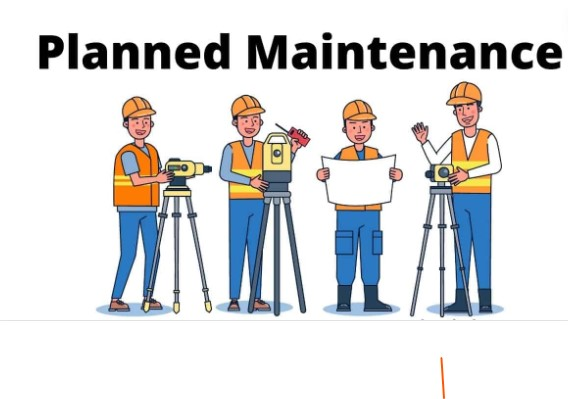
-
Implementing Planned Maintenance: Planned Maintenance involves scheduling routine maintenance tasks based on equipment condition and performance data. This proactive approach helps prevent unexpected breakdowns, extends equipment lifespan, and minimizes production disruptions.
-
Utilizing Proactive Replacement Schedule: A proactive replacement schedule is established to replace parts or components before they fail. By identifying and replacing failure-prone components during scheduled downtime, organizations can avoid costly breakdowns and reduce maintenance-related risks.
-
Implementing Autonomous Maintenance Program: Organizations establish and implement an Autonomous Maintenance Program to empower operators with the skills and knowledge to perform maintenance tasks independently. This program includes training sessions, standardized procedures, and regular equipment inspections to ensure ongoing equipment reliability.
-
Eliminating Waste and Addressing Major Losses: TPM aims to eliminate waste and address major losses through focused improvement initiatives. By identifying and eliminating sources of waste, such as equipment defects, downtime, and inefficiencies, organizations optimize production processes and enhance overall equipment effectiveness.
-
Performing Incremental Process Improvements: Continuous improvement is at the heart of TPM. Organizations encourage employees at all levels to identify opportunities for process improvement and implement incremental changes to enhance productivity, quality, and safety.
-
Maintaining a Robust Maintenance Schedule: A well-defined maintenance schedule is crucial for ensuring that preventive and corrective maintenance tasks are performed efficiently and on time. Organizations establish and adhere to a maintenance schedule to minimize equipment downtime and maintain peak operational performance.
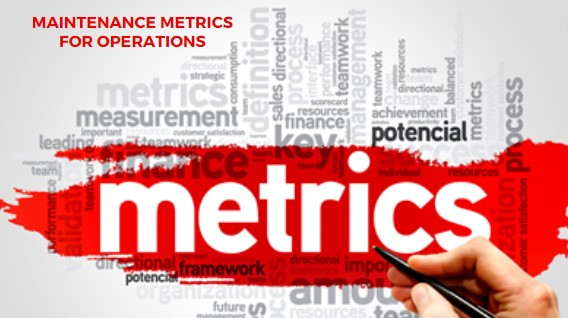
By following the TPM workflow, organizations can achieve sustained improvements in equipment reliability, productivity, and safety, ultimately driving operational excellence and competitiveness in today's dynamic manufacturing landscape.
Integration of Core Elements - 8 Pillars
a. Early equipment management
Early equipment management emphasizes the importance of proper equipment selection, installation, and commissioning. By ensuring that equipment is designed and installed correctly from the outset, organizations can prevent issues and optimize performance throughout its lifecycle.
b. Autonomous Maintenance
This pillar empowers operators to take ownership of equipment care and perform routine maintenance tasks. By involving frontline personnel in maintenance activities, organizations can enhance equipment effectiveness and foster a sense of responsibility among employees.
c. Continuous Improvement
Focused improvement encourages continuous improvement efforts aimed at eliminating losses and inefficiencies in equipment and processes. By engaging employees in problem-solving and root cause analysis, organizations can drive meaningful improvements in productivity and performance.
d. Planned Maintenance
Planned maintenance involves scheduling regular maintenance activities based on equipment condition and performance data. By proactively addressing maintenance needs, organizations can minimize unplanned downtime and extend equipment lifespan.
e. Quality Maintenance
Quality maintenance focuses on ensuring that equipment operates within specified quality standards. By maintaining equipment in optimal condition, organizations can prevent defects and improve product quality and customer satisfaction.
f. Training and education
Education and training are essential pillars of TPM, ensuring that personnel have the necessary knowledge and skills to perform their roles effectively. By investing in employee development, organizations can enhance overall equipment effectiveness and drive continuous improvement.
g. Safety, Health, and Environment
By prioritizing safety and environmental sustainability, organizations can create a safe and healthy work environment while minimizing negative impacts on the environment.
h. Office TPM
Administrative and office TPM extends the principles of TPM beyond the shop floor to administrative and support functions. By applying TPM principles to office processes, organizations can streamline workflows, reduce waste, and improve overall efficiency.
How to Implement TPM Effectively
Implementing Total Productive Maintenance (TPM) effectively requires a thorough understanding of its core elements and best practices tailored to the specific needs of different industries. By following a structured approach, organizations can maximize the benefits of TPM and achieve sustainable improvements in overall equipment effectiveness (OEE), productivity, and workplace safety.
Understanding the 5 Core Elements of TPM
Autonomous Maintenance: Autonomous maintenance empowers machine operators to perform routine maintenance tasks, such as cleaning, lubricating, and inspecting equipment. By involving operators in maintenance activities, organizations promote a sense of ownership and responsibility for equipment care.
Planned Maintenance: Planned maintenance involves scheduling regular maintenance activities based on equipment condition and performance data. This proactive approach helps prevent breakdowns and extends equipment lifespan, ultimately reducing unplanned downtime and production losses.
Quality Maintenance: Quality maintenance focuses on ensuring that equipment operates within specified quality standards to prevent defects and maintain product quality. By incorporating quality considerations into maintenance practices, organizations can enhance customer satisfaction and reduce rework and scrap.
Focused Improvement: Focused improvement initiatives aim to eliminate losses and inefficiencies in equipment and processes through continuous improvement efforts. By analyzing maintenance data and identifying root causes of equipment failures or performance issues, organizations can implement targeted improvement actions to optimize equipment efficiency and effectiveness.
Education and Training: Education and training are essential for ensuring that maintenance personnel have the necessary knowledge and skills to perform their roles effectively. By providing comprehensive training programs on TPM principles and practices, organizations can empower employees to contribute to TPM initiatives and drive continuous improvement.
Best Practices for Implementing TPM in Different Industries
Implementing Total Productive Maintenance (TPM) across diverse industries requires a nuanced approach that considers the unique challenges and requirements of each sector. Here are some best practices to effectively implement TPM in various industries:
Customization: Tailoring TPM implementation strategies to the specific needs of different industries and organizational contexts is crucial. Conduct thorough assessments to understand the equipment types, production processes, and regulatory requirements specific to each industry. Customize TPM methodologies, tools, and techniques accordingly to ensure alignment with industry standards and best practices.
Leadership Support: Securing commitment and support from top management is essential for the successful implementation of TPM initiatives. Leadership endorsement demonstrates the organization's commitment to TPM principles and fosters a culture of accountability and continuous improvement. Top management should provide the necessary resources, allocate budgets, and actively participate in TPM steering committees to drive organizational change effectively.
Employee Engagement: Involving employees at all levels in the TPM implementation process is critical for success. Encourage active participation and collaboration among frontline workers, maintenance personnel, supervisors, and managers. Empower employees to contribute ideas, identify improvement opportunities, and take ownership of TPM initiatives. Establish cross-functional teams to facilitate communication, problem-solving, and decision-making, ensuring that everyone feels valued and engaged in the process.

Continuous Monitoring and Evaluation: Establishing performance metrics and monitoring mechanisms is essential to track progress and identify areas for further improvement. Define key performance indicators (KPIs) related to equipment reliability, overall equipment effectiveness (OEE), downtime reduction, and maintenance costs. Implement robust data collection systems and software tools to capture real-time maintenance data, analyze trends, and identify root causes of equipment failures. Conduct regular performance reviews, audits, and assessments to evaluate TPM effectiveness and make data-driven decisions to optimize maintenance processes continually.
Knowledge Sharing: Foster a culture of knowledge sharing and collaboration to leverage collective expertise and experience in implementing TPM effectively. Encourage open communication channels, cross-training programs, and knowledge exchange sessions to facilitate the sharing of best practices, lessons learned, and success stories across departments and teams. Establish online forums, intranet portals, and knowledge repositories to centralize information and resources related to TPM methodologies, case studies, and success stories. Encourage mentoring and coaching relationships between experienced TPM practitioners and new team members to transfer tacit knowledge and build internal capabilities.
By implementing these best practices tailored to the unique needs of different industries, organizations can unlock the full potential of TPM and drive sustainable improvements in equipment reliability, productivity, and overall operational performance. A well-executed TPM strategy not only enhances equipment effectiveness but also cultivates a culture of continuous improvement and innovation, positioning organizations for long-term success in today's competitive marketplace.
Calculating TPM
Calculating Total Productive Maintenance (TPM) involves assessing the effectiveness of maintenance efforts in optimizing equipment performance and minimizing downtime. By measuring TPM metrics, organizations can evaluate the success of their maintenance strategies and identify areas for improvement. Here's an overview of methods for calculating TPM and the importance of TPM metrics:
Methods for Calculating TPM
-
Overall Equipment Effectiveness (OEE): OEE is a widely used metric for calculating TPM effectiveness. It measures the productivity of equipment by considering three factors: availability, performance, and quality. OEE provides a comprehensive view of equipment performance and helps identify areas of inefficiency or waste.
-
Mean Time Between Failures (MTBF): MTBF measures the average time elapsed between equipment failures. It is calculated by dividing the total operating time by the number of failures within a specific period. MTBF helps assess equipment reliability and predict maintenance needs.
-
Mean Time to Repair (MTTR): MTTR measures the average time required to repair equipment after a failure occurs. It is calculated by dividing the total downtime due to repairs by the number of repair incidents. MTTR provides insights into maintenance efficiency and helps minimize equipment downtime.
-
Overall Maintenance Effectiveness (OME): OME evaluates the effectiveness of maintenance activities in preventing equipment failures and maximizing uptime. It considers factors such as preventive maintenance completion rate, mean time to detect failures, and mean time to repair. OME helps assess the overall performance of maintenance programs.
Importance of TPM Metrics
-
Performance Evaluation: TPM metrics provide valuable insights into equipment performance and maintenance effectiveness. By tracking metrics such as OEE, MTBF, and MTTR, organizations can evaluate the impact of maintenance initiatives on equipment reliability, productivity, and downtime reduction.
-
Identifying Improvement Opportunities: TPM metrics highlight areas for improvement and help prioritize maintenance efforts. By analyzing trends and performance data, organizations can identify recurring issues, failure patterns, and maintenance bottlenecks. This enables them to implement targeted improvement strategies and optimize maintenance schedules.
-
Optimizing Resource Allocation: TPM metrics assist in optimizing resource allocation and budget planning. By understanding maintenance requirements and equipment reliability, organizations can allocate resources more efficiently, minimize costs, and maximize return on investment (ROI).
-
Benchmarking and Comparison: TPM metrics facilitate benchmarking and comparison with industry standards and best practices. By comparing performance metrics against industry benchmarks or peer organizations, organizations can identify areas of strength and weakness and set realistic improvement targets.
-
Continuous Improvement: TPM metrics support a culture of continuous improvement by providing feedback on maintenance performance and encouraging ongoing optimization. By monitoring metrics regularly and implementing corrective actions, organizations can drive incremental process improvements and strive for perfect production.
Calculating TPM through various metrics is essential for assessing maintenance effectiveness, identifying improvement opportunities, and driving continuous improvement. By leveraging TPM metrics, organizations can optimize equipment performance, minimize downtime, and achieve operational excellence in today's competitive environment.
Conclusion
Total Productive Maintenance (TPM) stands as a cornerstone in the realm of maintenance management, offering a holistic approach to optimizing equipment effectiveness and operational efficiency. By implementing TPM methodologies, organizations can proactively address maintenance challenges, minimize downtime, and maximize productivity.
Through preventive maintenance practices, such as regular inspections and scheduled repairs, organizations can mitigate the risk of equipment failures and prolong asset lifespan. Moreover, proactive maintenance techniques empower maintenance staff and equipment operators to take ownership of equipment care, ensuring timely interventions and swift resolutions to issues before they escalate.
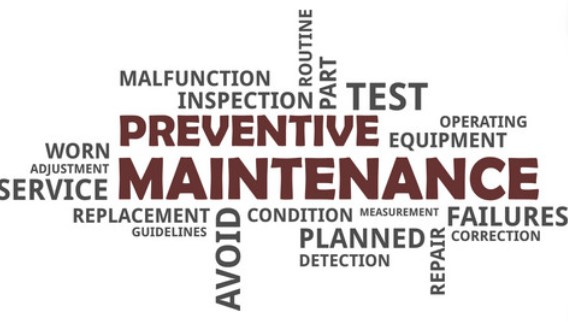
The implementation of TPM not only aims to restore equipment to its prime operating condition but also fosters a culture of continuous improvement within the maintenance team. By embracing proactive maintenance programs and establishing regular maintenance intervals, organizations can streamline operations, enhance reliability, and reduce costs associated with unplanned downtime.
TPM transcends traditional maintenance approaches by emphasizing proactive strategies, collaborative teamwork, and a relentless pursuit of perfection. By harnessing the power of TPM, organizations can optimize their maintenance practices, elevate equipment performance, and achieve sustainable success in today's competitive landscape.